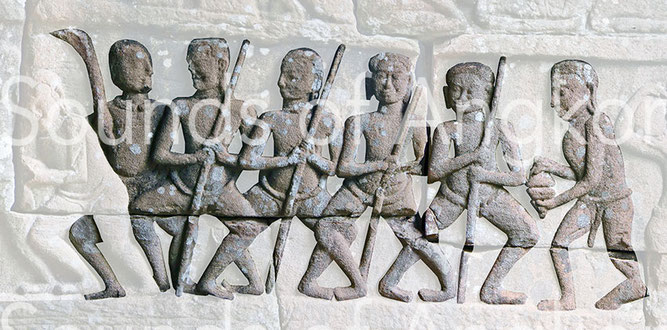Last update: December 3, 2023
Cymbals, large and small, are widely represented in the iconography and are present in all musical ensembles: martial, palatine, religious, entertainment and even to accompany the work. Some original objects have come down to us. Even if they belong to the same family of instruments, their shape, use and playing technique are different. The large cymbals have essentially a martial use. The small ones are used in all other ensembles. Both are made of bronze (an alloy of copper, tin and/or lead).
Playing technique
In all the properly Angkorian representations, the two elements to be clinked or rubbed are held one above the other, the left hand underneath. The two elements are either connected by a cord or are free. In general, they are shown separated by a few centimeters or closed. On a pre-Angkorian lintel of Sambor Prei Kuk (7th century), the musician strikes them with vehemence. His right hand seems to hold a handful. The Newar of the Kathmandu Valley in Nepal use this kind of instrument in the Bhajan music to praise the deities of Hinduism.
Cymbals through archaeology
Archaeology has delivered bronze cymbals with hemispherical and conical caps. An investigation with bronze specialists would make it possible to decide whether the instruments were cast or forged.
The cymbals with integral handle (below) come from Banteay Chhmar; they measure 22 cm in diameter. This type of instrument is still used in Vietnam.
Small cymbals through archaeology
A few examples of small cymbals have come down to us, coming from official archaeological excavations or discovered by chance. Their state of preservation, given the thickness of the metal and perhaps also the quality of the alloys, make it possible to make them sound and hear the original sound. They are pierced with a central hole allowing to bind them and to hold them for playing.
Cymbals through epigraphy
Two distinct terminologies appear in Old Khmer texts: tāla or its variant tāl, derived from Sanskrit tāla or tala and cheṅ associated with the functional term chmāp designating the one who "manipulates" them. These two terms were indifferently translated by gong or cymbal(s) by the epigraphists. In the case of gong, it could only be, in the pre-Angkorian and Angkorian periods, flat gongs and not bossed ones. In his dictionary of Old Khmer, Saveros Pou brings a corrigendum. She proposes that tāla be translated as "gong" from Old Khmer. But we think that there is no need to systematize because no gong appears definitely in Khmer, Indian or Javanese iconography and archeology has officially given us no instrument despite a good preservation of the bronze. If cymbals are officially already out of the ground, the gongs are waiting!
Tāla benefits from at least four occurrences until the 11th century and one to the 14th century, generally associated with the material. Here are two:
- K. 389, pre-Angkorian, kaṅsatāla piy samṛt - three tāla in bronze or brass.
- K. 370, 11th century, tāla saṃmrit - tāla in bronze or brass.
If one approximates the number of occurrences tāla of the exceptional quantity of representations of cymbals, the probability that the correct translation is the cymbals increases considerably. As for cheṅ, which also appears with a significant number of occurrences, we are tempted to reason in the same way. Moreover, the term chmāp, translated by Saveros Pou as "manipulator", demonstrates that there are, in the way of playing, other operations than a simple percussion of gong, which corresponds to the reality of the game of cymbals as evidenced by ethnology.
Another argument reinforces this sense of importance of the cymbals in ancient Khmer society. On this scene of the Bayon below which adjoins an image of temple builders, a manipulator of cymbals gives the cadence to five men equipped with sticks or dams with which they rhythmically strike the ground for the edification.
All this would be simple if the inscription of Prasat Komphus did not come to play the troublemakers. Among his lists of donations to the temple, one is devoted to copper alloy objects and we find the words cheṅ 4, tāla 6. Next, two names for cymbals (?). One could then say that cheṅ would represent cymbals and tāla gongs. But two instances later, we find 'koṛ panṛum 6' that G. Cœdès translated by '6 wrapped gongs'! Ethnology shows that ethnic minorities in the border areas of Cambodia, Laos and Vietnam protect and transport their gongs in woven containers the size of the largest of them. We propose, however, another hypothesis: there could actually be two types of cymbals as they still exist today for example in the bhajan musician-singers of the Kathmandu valley in Nepal: on one side, thick cymbals (cheṅ), on the other, thin cymbals (tāla). Koṛ panṛum could then designate a wrapped drum. In Laos, the generic term kong designates drums and it is customary to wrap them in fabrics, as in many other parts of Southeast Asia and India. But this is only a hypothesis ...
Reconstruction of Angkorian cymbals
In 2012, we found, in the suburbs of Phnom Penh, close to the airport area, one of the last craftsmen making bulbous gongs for roneat. He agreed to make, for Sounds of Angkor, cymbals by hammering from a bronze wafer of similar thickness to that of Angkorian instruments. The images opposite give an account of the work. The circular wafers are made in situ from reclaimed metal.
















































